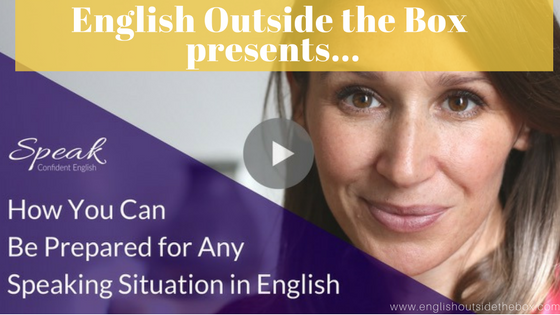
How You Can Be Prepared for Any Speaking Situation in English
Welcome back to another special blog + video lesson! [Or, if it’s your first time, welcome to learning outside the box!] As you know, the last few weeks have been extra special here on English Outside the Box, because they focused on your October Learning Plan. This week is unique as well because you are going to be learning how to be fluent in English with Annemarie from Speak Confident English.
I am over the moon (*extremely happy*) to share this guest post from Annemarie, as she’ll provide you valuable information regarding your fluency skills. Today’s lesson is similar to the ‘5 Minute English’ weekly lessons you’re used to on this blog; however, the video is slightly longer. So, if you’re tight on time (*if you’re busy*) make sure to bookmark/save the lesson to finish later!
Now, are you ready to begin today’s lesson?
Take it away Annemarie…
I know that one of the reasons you join English Outside the Box every week is become more fluent in English.
What that really means is you want it to be easy to speak in English in any situation. You want to express yourself freely, remember the words you’ve learned, and feel confident. And the good news is: all of that is possible. It’s possible with practice.
Last week Jennifer shared Week 4 of her 31 Daily English lessons and it was focused 100% on speaking. Many of you found new conversation partners and joined conversation clubs. And that’s awesome! It’s another step in the right direction.
But what now? What should you practice with your partner? And how you can truly develop the ability to be fluent in English?
That’s exactly what I’m going to share with you today: How You Can Be Prepared for Any Speaking Situation in English.
With my Fluency School course, I’ve developed 3 categories of speaking skills that you need to develop to truly be fluent in English. Today I’ll share those with you and provide you with 3 activities to get you started.
The Three Skills You Need to Practice in English + Activities
Everyday Exchanges
Everyday exchanges are the daily conversations we have on the familiar topics for example, how you spend your weekends, your hobbies and interests, family, culture, or what you do at work.
These are the conversations that you have with your colleagues at work in the morning, the conversations you have with your neighbors when you see them, or when you meet a new person at a party.
Such basic question and answer conversations allow you to get to know others, build relationships, and make friends.
And for you to have these conversations successfully in English, you need to know:
- What questions you can/should ask
- How to ask the questions
- Your answers to these questions
Activity Idea
To help you develop your skills in Everyday Exchanges, follow these steps with your conversation partner or conversation club:
Step 1:
Agree on a familiar topic to discuss. This can be hobbies, work, vacations, holidays, culture, food, etc.
Step 2:
Together, create a list of common questions on this topic. Create as many questions ask you can. It’s okay if some questions are very similar. This will give you more practice.
Step 3:
Practice asking and answering these questions with your partner.
Speak at Length
The next big step in developing your English fluency skills is your ability to speak at length in English. This means speaking on a topic for more than 2 minutes.
For example, imagine your boss asked you to present information about your company at a business meeting or maybe you need to summarize some important company research.
Or perhaps you’d like to share a funny story from your last vacation with your friends.
The good news about situations when you speak at length is you often have some time to prepare. Most of the time, for a business meeting, you can prepare your answers and practice.
But you also need to make sure your comments in English are well-organized, easy to understand, and clear. To do this, we often use functional language to help us.
Functional language are those words and expressions that help us to summarize or clarify information, provide a sequence or order events, organize details, and much more.
How can you practice and improve your ability to speak at length in English? Great question! Try this.
Activity Idea
Step 1: Choose a podcast to listen to with your conversation partner. (Need ideas? Try English Across the Pond.)
Step 2: After listening, prepare a summary of the podcast. What were the key points? What important details should you highlight?
Step 3: You and your partner can present your summaries to each other. Be sure that your summary is more than two minutes long.
This activity helps you to feel more comfortable to speak at length and you are practicing skills such as: presentations, summarizing information, and sharing an opinion.
Bonus! This activity will also help you develop your vocabulary through repetition of using and hearing the same vocabulary and expressions in the summaries.
Participate in Discussions
And finally, the third skill you need to develop in English to truly be prepared for any speaking situation is your ability to participate in discussions.
Imagine you go to dinner with some friends and there is a guest from Canada visiting so everyone is speaking English. The topic of conversation keeps changing but everyone is laughing, asking questions, and enjoying the evening. Wouldn’t you love to join them?
Participating in an English discussion can be challenging because you must:
- Speak about a topic that may be unfamiliar to you
- Understand all the people participating in the conversation
- Be spontaneous and able to speak with little preparation
- Prepare to agree/disagree or express your opinion
- Answer questions that are unexpected
But the good news is, you absolutely CAN develop this skill in English with practice. So let’s get to your finally activity.
Activity Idea
Step 1: Choose a topic of interest with your partner.
Step 2: Find an article to read on that topic from a newspaper, magazine, or blog.
Step 3: After you read, each of you should prepare 3-4 questions that you can ask during a discussion on the topic. These questions can ask about someone’s opinion, agreement, experiences, ideas, etc.
Step 4: Begin the discussion by summarizing or highlighting the key points of the article. Then ask each other your questions.
And Now It’s Time for You to Practice!
And now you have three activities you can start using NOW with your conversation partner.
These skills will help you develop your skills so you can be prepared in any speaking situation. With these activities, you’ll improve your skills for:
- Getting to know someone
- Building relationships
- Making friends
- Summarizing and presenting information
- Expressing your opinion
- Sharing ideas and telling stories
- Participating in conversations
- Agreeing and disagreeing with others
- Answering unexpected questions
Enjoy these activities!
– – – – – – – – –
About the author:
 Annemarie is the founder of Speak Confident English where she helps professional women become confident and fluent in English. Her Fluency School course is a 4-week, small-group speaking course designed to help women feel natural and speak professionally in any situation in English.
Annemarie is the founder of Speak Confident English where she helps professional women become confident and fluent in English. Her Fluency School course is a 4-week, small-group speaking course designed to help women feel natural and speak professionally in any situation in English.
– – – – – – – – –
Remember to be fluent in English you must practice, practice, practice! So don’t hesitate to get started with Annemarie’s speaking activities, and check out her fluency course!
Don’t forget to share your experience with today’s lesson in the comment section below! And if you’re looking for a partner, pop on over to my Instagram and check comment on this post to find one!

I love the lesson “How You Can Be Prepared for Any Speaking Situation in English”! One of the reasons is that I know Annemarie as a brilliant teacher. All her lessons are interesting and useful. And I’m very happy that more and people have the great opportunity to watch them and find a lot of useful information for improving their English! Thank you!
Yes, I agree she is a brilliant teacher! So happy you love the lesson!